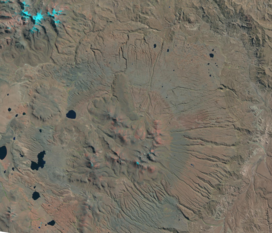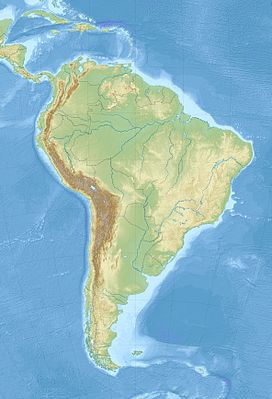22°15′S 66°45′W / 22.250°S 66.750°W[1]
| Cerro Panizos | |
|---|---|
 The lava domes in the centre of the image form the Panizos centre. Image is about 50 kilometres (31 mi) across. | |
| Geography | |
| Parent range | Cordillera de Lípez |
| Geology | |
| Volcanic arc/belt | Altiplano-Puna volcanic complex |
| Last eruption | 6.1 mya |
Cerro Panizos is a late Miocene[a]-age shield-shaped volcano spanning the Potosi Department of Bolivia and the Jujuy Province of Argentina. It features two calderas (depressions formed by the collapse of a volcano) and a group of lava domes. It is part of the Altiplano-Puna volcanic complex (APVC), a group of calderas and associated ignimbrites (a form of volcanic rock) that erupted during the past ten million years. Cerro Panizos is part of the Central Volcanic Zone (CVZ), a volcanic arc that extends from Peru to Chile which was formed mostly by subduction of the Nazca Plate beneath South America.
Volcanic activity commenced in the APVC about ten million years ago, producing the large volcanic calderas Panizos, Vilama, Cerro Guacha and the volcano Uturuncu. The formation of the APVC has been linked to the existence of a giant magmatic body in the crust of the Central Andes.
The Cienago Ignimbrite erupted over 350 cubic kilometres (84 cu mi) from Panizos about 7.9 million years ago, and 6.7 million years ago the Panizos Ignimbrite erupted over 650 cubic kilometres (160 cu mi). The Panizos Ignimbrite has been noted for volcanic rocks containing orbs[b]. Several volcanic cones such as Limitayoc were active between the ignimbrite eruptions, and a plateau of lava flows and lava domes formed in the central area of the Panizos Ignimbrite after the last eruptions.
Cite error: There are <ref group=lower-alpha> tags or {{efn}} templates on this page, but the references will not show without a {{reflist|group=lower-alpha}} template or {{notelist}} template (see the help page).

